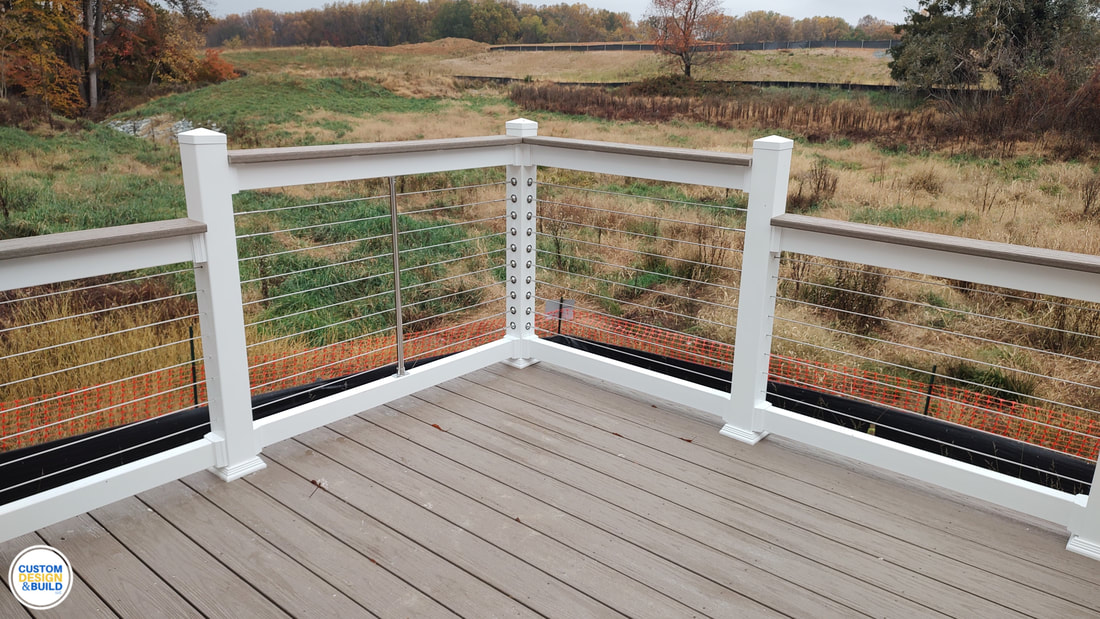How To Choose Your Deck Railing: Vinyl, Composite or Aluminum?

Selecting the perfect railing for your custom design and build project is an essential decision that encompasses both aesthetics and functionality. Today, we’ll delve deep into the primary contenders: Vinyl, Composite, and Aluminum. By considering durability, appearance, cost, environmental impact, and installation, we aim to help you make an informed choice for your space.
1. Durability & Maintenance
- Vinyl Railings: These champions against environmental adversaries are designed to withstand UV rays, water, and insect damage. With no threat of rotting or rusting and no need for painting, they’re a low-maintenance choice. However, extended sun exposure might lead to brittleness or discoloration over time.
- Composite Railings: A beautiful fusion of wood fibers and plastic, these railings boast the aesthetics of wood without its tedious maintenance. While they stand resistant to staining and fading, they might show scratches more easily than their counterparts.
- Aluminum Railings: Built to last, these railings resist rust, corrosion, and the damaging effects of UV rays. Requiring minimal maintenance, they’re perfect for those seeking longevity with little upkeep.
2. Aesthetics
- Vinyl: Simple and modern, vinyl railings offer a crisp look. However, purists might miss the traditional touch of natural materials.
- Composite: Perfect for those yearning for wood-like elegance without the associated hassle. They can mimic natural grains, offering a vast palette of colors.
- Aluminum: Sleek, chic, and contemporary, these railings add a touch of modernity to spaces and blend seamlessly with avant-garde architectural designs.
3. Cost Considerations
- Vinyl: If budget-friendliness tops your list, vinyl won’t disappoint. But do consider its lifespan, which might be shorter than the other options.
- Composite: With a mid-range price tag, the initial investment is balanced by its impressive durability and minimal maintenance needs.
- Aluminum: A bit on the expensive side, but their longevity and near-zero maintenance requirements often justify the initial expenditure.
4. Environmental Implications
- Vinyl and Composite: Their enduring nature reduces frequent replacements, but manufacturing and disposal processes do pose environmental concerns.
- Aluminum: An eco-warrior at heart, aluminum railings are recyclable, making them a green choice for eco-conscious homeowners.
5. Installation & Flexibility
- Vinyl: Installation is a breeze, but design aficionados might find its flexibility a tad limiting.
- Composite: More adaptable than vinyl in terms of design, allowing for a broader creative expression.
- Aluminum: Widely regarded as the design-flexible contender, aluminum is adaptable to various architectural styles and visions.
Final Thoughts
The quest for the perfect railing boils down to personal preferences, budgetary constraints, and specific project needs. Whether you lean towards the modern charm of vinyl, the wood-like elegance of composite, or the contemporary sleekness of aluminum, each offers unique benefits.
For further assistance or to discuss your project in detail, feel free to reach out. Remember, the right choice not only adds beauty but also enhances the safety and longevity of your space.

